#tube station
Text

Cyril Power (British, 1872-1951), The Tube Staircase, 1929. Linocut printed in yellow, cobalt blue and black on thin oriental laid paper, block: 444 x 258 mm.; sheet: 532 x 320 mm. Numbered 30/50
#cyril edward power#cyril power#british art#english art#stairs#staircase#underground#tube station#russell square tube station#london underground
4K notes
·
View notes
Text

Me in an abandoned Stockholm tube station, 2000 or 2001. Photo by Theodor Johansson.
#oi!#skinnskalle#ska#subculture#sweden#boots#punk#sharp#swedish#stockholmsuniversitet#stockholmstunnelbana#tube station
48 notes
·
View notes
Text
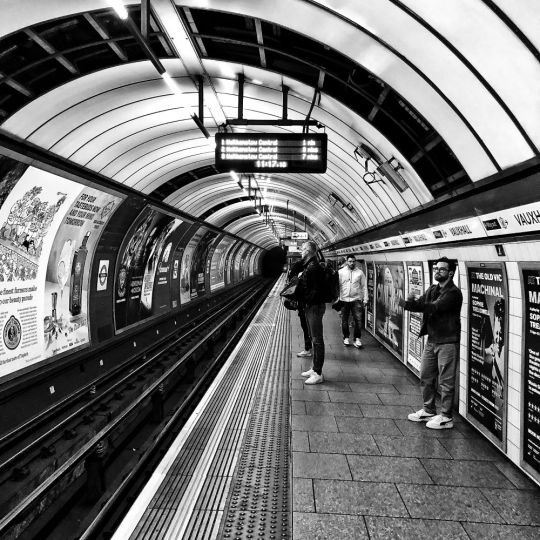
Vauxhall station, London, April 2024.
#black and white photography#city photography#iphone photography#london#london underground#original photographers#photographers on tumblr#photography#railway station#south london#train station#the tube#tube station#urban photography
15 notes
·
View notes
Text

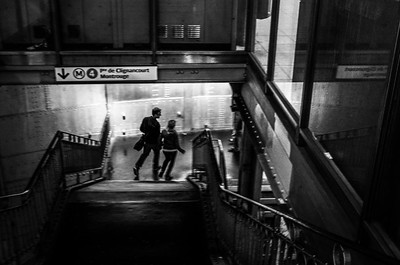

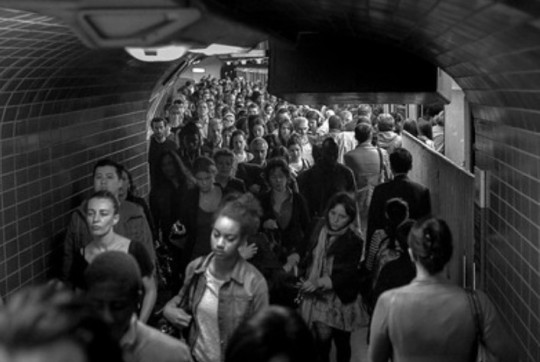



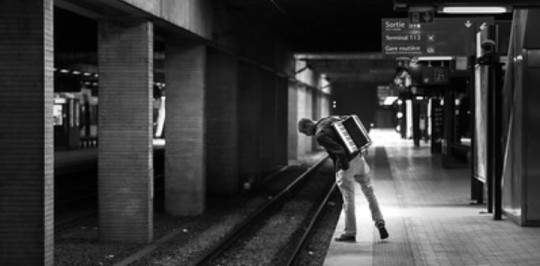


Metro photos by Sungsoo Lee, ©SungsooLee.com 2008-present.
#sungsoo lee#photography#urban photography#street photography#b&w photography#metropolitana#metro#subway#underground#tube station#paris#new york#2008-2016#flickr
14 notes
·
View notes
Text

DAN HAS POSTERS IN THE TUBE STATIONS OH MY GOD 🤯😱🤯😱😱
#dan and phil#daniel howell#phandom#dnp#youtuber#dan howell#phil lester#amazing phil#loveislove#phanart#danielhowell#amazingphil#phan#danisnotonfire#youtube#dan#tube station#poster
265 notes
·
View notes
Text
Okay so I know this is crazy but today I made eye contact with a girl while she was on the tube and I was on the platform and I thought she was really fucking pretty but I have anxiety so I kept looking away and then looking back and my only thought when her train went away was ‘damn I should have smiled at her.’
And anyway, if you have black hair, black eyeliner, dark eyes, and an (I think) orange bag on a train to Edgware and a girl with a green coat, brown hair, and purple eyeliner stared at you from the platform of Tottenham Court Road at approximately 3:30PM on February 12, 2024, I think you’re really pretty
4 notes
·
View notes
Text

I don’t know if Tube Stations I Think Are Cute is super niche an art subject for most people, but I loved painting lil Nigel and Antwan outside Maida Vale station, one of my favourite stations in London. Maybe they’ll cross the street to the bakery and have a coffee and cake, or maybe some lovely fruit from the greengrocers for a picnic in the park nearby. Whatever they get up to on their adventure together, I’m sure it will be a lovely day.
#npceo#nigel billingsley#antwan hovachelik#jumanji#free guy#maida vale#london#tube station#london underground#watercolour#architecture#taika waititi#rhys darby#whimsical art#art
17 notes
·
View notes
Text

The other day, @cuties-in-codices had a great question: why are so many elephants in medieval European manuscripts depicted with castles on their backs? Even today, there is the Elephant and Castle Underground Station in London (perhaps named after a pub). (Image source: x)
The iconography ultimately derives from descriptions of war elephants in ancient texts which were read, copied, and translated in northern Europe. One of the things I'm studying is how elephants featured prominently in medieval European art and poetry, even among people who had never seen one, and how these links can show intellectual networks and the long impact of north African and Asian writers on world literature.
There are records of elephants being used in war in a number of ancient contexts. The most famous examples today are the leaders of Carthage, including Hannibal, but they were also recorded in India and in connection to Alexander's successors. These stories from Plutarch, Orosius, and other ancient writers filtered down to northern Europeans, who imagined elephants carrying whole forts/castles on their backs. Stay tuned for more!

Coin of Seleucus I Nicator (d. 281 BC) showing a fantastical view of his chariot being pulled by elephants (British Museum, Coins and Medals 2002,0101.1329 )
#elephant#elephants#war elephant#london underground#tube station#elephant and castle#seleucus nicator#coins
7 notes
·
View notes
Text

Tube Station, London
#photography#contemporary art#fine art photography#travel photography#wanderlust#London#street photography#Tube station#original photography#photography on tumblr#black and white photography#travel
7 notes
·
View notes
Text

Down at the tube station, post morning rush. Rådhuset. Kungsholmen, Stockholm, Sweden. June 2023.
7 notes
·
View notes
Photo
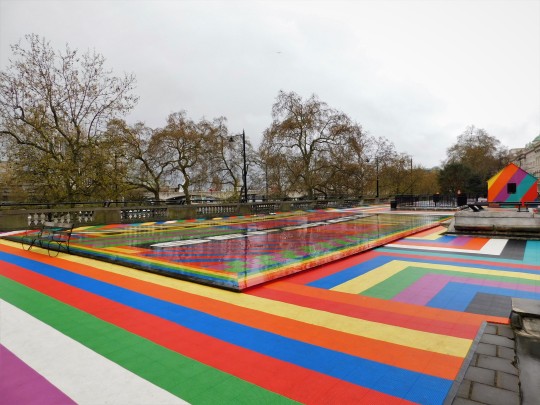
Lost London: Walking the Covent Garden Drainage Ditches
With apologies for the slightly unappealing title – the watercourses that drained the area we now know as Covent Garden may not have ever been rivers or streams, hence it feels inappropriate to definitively categorise these as lost rivers. However, they definitely carried water to the Thames, may once have been streams that have been rechannelled, and still exist in a culverted form, with some small traces to be found at street level.
This is a walk in three parts, starting and finishing at the Thames, following first the Bloomsbury Ditch, followed by the Cock and Pye Ditch, and finally the St Martin’s parish sewer.
Part 1: The Bloomsbury Ditch

This drainage channel, also referred to in some sources as the Southampton Sewer, took water from the Cock and Pye Ditch and other surrounding marshy areas between Covent Garden and the Thames. Its outfall is no longer visible, having been channelled into the main sewer of the Victoria Embankment, which was completed in 1870. The closest one can get to it nowadays is Temple Place, the original line of the riverbank. A good place to start the walk is the rooftop section of Victoria Embankment Gardens, above Temple tube station; this has recently been transformed into an outdoor art space, but it also provides a good view out over the Thames.
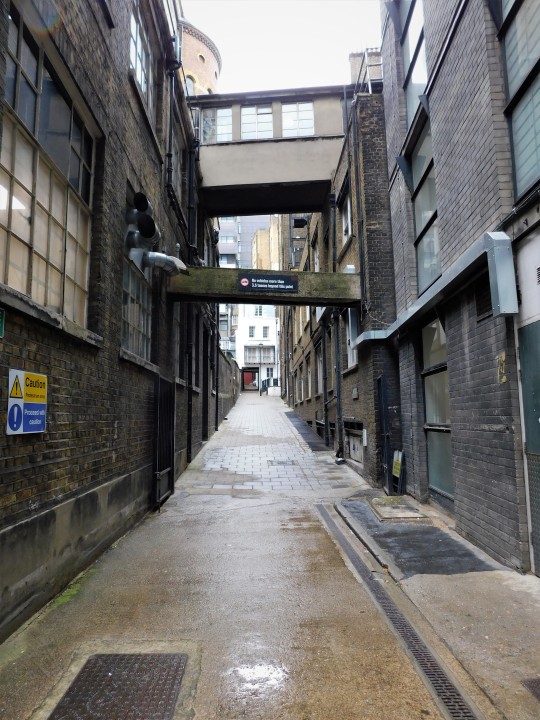
Leaving the Thames behind (for now), the route of the Bloomsbury Ditch can be traced along Strand Lane, a dead-end road that cuts between buildings of King’s College London’s Strand campus. Strand Lane climbs steadily upwards, bringing the walker to the fake “Roman” baths (previously featured on this blog), which are supposedly managed by the National Trust, though have never seemed to be in particularly good condition on any of my previous visits. The (gated) steps up to Surrey Street by the baths show how much lower Strand Lane is, suggesting this was indeed once the drainage valley.

Doubling back and then around to Surrey Street (due to the aforementioned dead end and gated steps), passing the closed Aldwych station, and crossing the Strand by St Mary-le-Strand church, the best way forward here is Melbourne Place, as the ditch runs under Bush House, which formerly belonged to the BBC, and is now also inhabited by King’s College. The route then takes the walker across Aldwych, which was recently changed over to two-way traffic, the latest chapter in the saga of transport improvements associated with Aldwych and adjoining Kingsway.
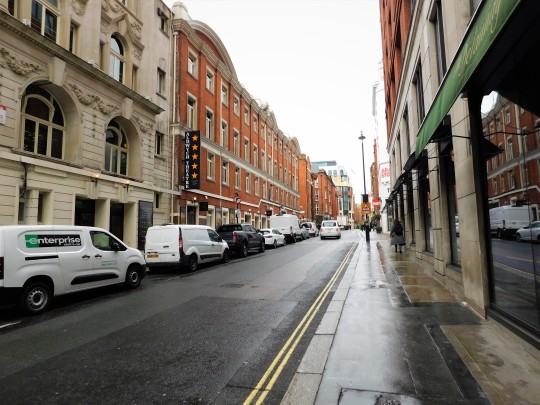
Getting back on track, the course of the Bloomsbury Ditch can be picked up again along Drury Lane, which rises gradually uphill towards Covent Garden. Drury Lane is probably best known for its theatres and/or as the erstwhile residence of a muffin man, though this walk passes a few other places of interest, including the former burial ground of St John’s Church (now a children’s playground) and the Peabody Building, once the Lambert and Butler tobacco factory.
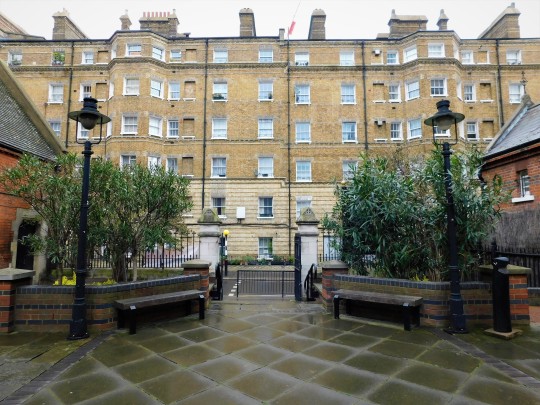
Sources are vague on where the Bloomsbury Ditch and Cock and Pye Ditch meet (some even treat them as the same ditch). However, a good place to stop with this leg of the walk would seem to be outside the Gillian Lynne Theatre, looking across to a dark alley that leads into the heart of Covent Garden…
#london#uk#england#walk#covent garden#ditch#drainage#watercourse#stream#bloomsbury#cock and pye#sewer#victoria embankment#embankment#temple#tube station#tube#gardens#art#strand#the strand#kings college#roman baths#aldwych#drury lane#theatre#theatres#lost river#history#lundene
12 notes
·
View notes
Text

Nine Elms station, South London, March 2024.
#city photography#iphone photography#london#london underground#nine elms station#northern line#original photographers#photographers on tumblr#photography#railway station#south london#train station#the tube#tube station#urban photography
8 notes
·
View notes
Text
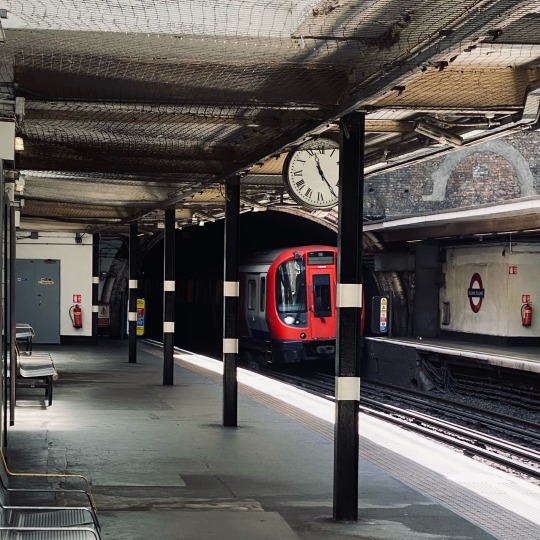
Sloane Square
2 notes
·
View notes
Text

London PSA
8 notes
·
View notes
Text

2 notes
·
View notes